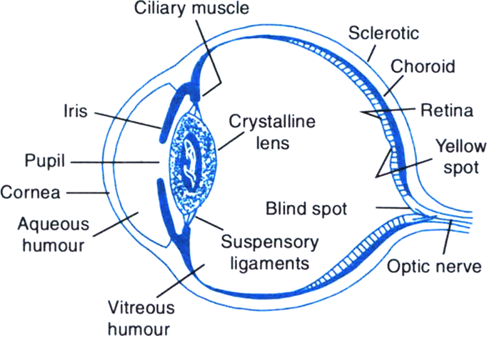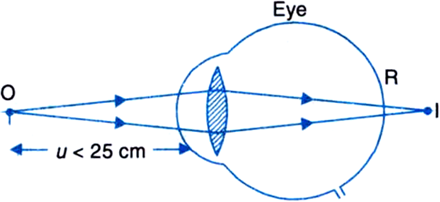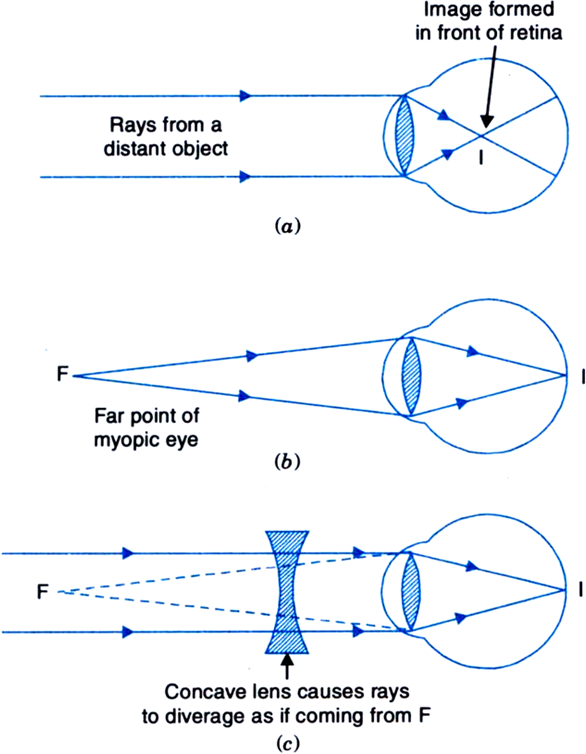Accommodation: Accommodation is the ability or property of the eyelens due to which it can change its curvature or focal length so that images of objects at various distances can be formed on the same retina. The focal length of the eyelens is automatically changed with the help of ciliary muscles as follows:
(i) Viewing far off objects: When the ciliary muscles are completely relaxed, the eyelens is thin and its focal length is maximum (equal to distance between eyelens and retina). The rays coming from the distant object are parallel to each other and they are focussed at the retina as shown in Fig.(a).
Fig. Accommodation of eyelens (a) Focussing parallel rays from infinity i.e., far point (b) Focussing rays from near point N.
(ii) Viewing nearby objects: When we look at a nearby object, the ciliary muscles contract, the eyelens bulges out and becomes thick and its focal length is reduced. This focusses the light from the nearby object on the retina, as shown in Fig. (b).

Define the following terms and give their values for a normal eye:
(i) Range of normal vision.
(ii) Least distance of distinct vision.
(iii) Near point of the eye.
(iv) Far point of the eye.
(v) Power of accommodation.

Points of similarity:
|
Camera |
Human eye |
|
2. A real and inverted image is formed on the photographic film. 3. Diaphragm controls the amount of light entering the camera. 4. Time of exposure is controlled by a shutter. |
1. Image is formed by the eyelens (a convex lens) made of fibrous, jelly like material. 2. A real and inverted image is formed on the retina. 3. Pupil in the iris controls the amount of light entering the eye. 4. Time of exposure is controlled by the eyelids. |
Points of dissimilarity:
|
Camera |
Human eye |
|
1. Focal length of camera lens is fixed. 2. Focussing is done by changing the distance between the camera lens and the photographic film. 3. Photographic film retains the image permanently. 4. A photograph has to be changed for getting next image. 5. The angular region covered is about 60°. |
1. Focal length of eyelens can be changed with the help of ciliary muscles. 2. Focussing is done by changing the shape of the eyelens by the action of ciliary muscles. 3.The retina of the eye retains the impression of an image for about (1/16)th of a second. 4. The same retina can be used for viewing an unlimited number of images. 5. The angular region covered is about 150°. |
(a) What is myopia? State two reasons due to which this effect is caused.
(b) Draw a diagram to show the formation of image of a distant object by a myopic eye. How can such an eye defect be remedied?
Or
State two main causes of a person developing near sightedness. With the help of a ray diagram, suggest how he can be helped to overcome this disability.
Myopia or short-sightedness: It is a vision defect in which a person can see nearby objects clearly but cannot see the distant objects clearly beyond a certain point. This defect is common among children.
Cause of myopia: This defect arises due to either of the following two reasons:
(i) The eyeball gets elongated along its axis so that the distance between the eyelens and the retina becomes larger.
(ii) The focal length of the eyelens becomes too short due to the excessive curvature of cornea.
Fig. Myopic and its correction
As a result of the above causes, the parallel rays coming from a distant object do not meet at the retina but at a point in front of the retina, as shown in Fig. (a) and the distant object is not seen clearly. The object has to be moved closer to the eye to a point F to focus it on the retina, as shown in Fig. (b). Thus, the far point of a myopic eye is not at infinity but only a few metres from the eye.
Correction of Myopia: A myopic eye is corrected by using a concave lens of focal length equal to the distance of the far point F from the eye. This lens diverges the parallel rays from distant object as if they are coming from the far point F. Finally, the eyelens forms a clear image at the retina.
